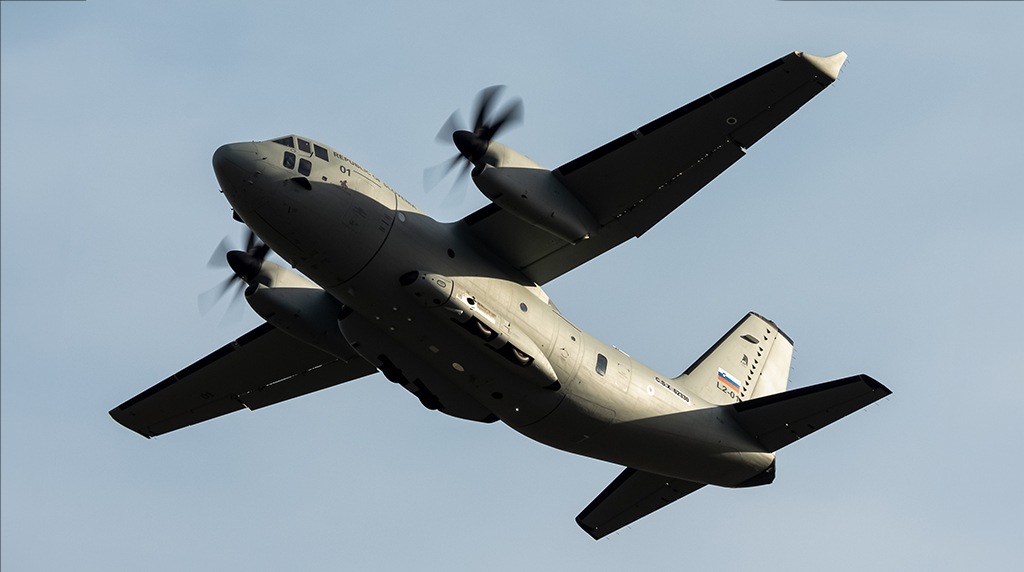Slovenian Air Force will receive a second C-27J Spartan multi-role military transport aircraft along with related logistics and training services.
A second C-27J Spartan for the Slovenian Air Force, along with related logistics and training services, will be supplied to the Slovenian Defence Ministry following a Purchase Contract signed by Leonardo and the Air Armaments and Airworthiness Directorate of the Secretariat General of Defence / National Armaments Directorate.
The contract follows the Italy-Slovenia Government-to-Government agreement (G2G) signed on 17 November 2021, aiming to strengthen bilateral cooperation between the two countries, says Leonardo.
The aircraft, a C-27J Spartan NG (Next Generation) sporting Slovenian Air Force colours and serial L2-01, along with the temporary Italian experimental registration CSX62330 (c/n 4204), was first spotted carrying out test flights in January 2023. The airframe will join the 15 Polk Vojaškega Letalstva (PVL, 15th Aviation Regiment) at Ljubljana/Brnik once delivered.
Interestingly, along with the press statement the company provided a previously unreleased image showing the aircraft.
Here are some details about the C-27 Spartan NG we included in a detailed article on the type we published in 2020:
The improved aircraft features new equipment, avionics and aerodynamic devices, most notably new winglets, that are intended to boost even more the performance and reliability of the Spartan.
After the announcement about the C-27J Next Generation, Leonardo published on its website an interview with the company’s test pilot Matteo Maurizio, Head of Project Test Pilot Airlifters, Special Versions and UAS, who has been involved in the development of the new variant of the Spartan since its first test flights. Here is how he describes the improvements:
The main differences relate to the aircraft’s flying qualities and performance. In terms of quality, I must stress that the new state-of-the-art avionics technology fully complies with the most up-to-date international standard, called Performance Based Navigation and to have in the cockpit new features as FANS1/A+ Datalink, TCAS 7.1, ILS Cat II and Enhanced Video TAWS. This enables us to exploit all the capabilities offered by the operation in civil air spaces with no limitations and to enhance interoperability in tactical military scenarios with the integration of Mode 5 IFF/ADS-B out, tactical VNAV and Search and Rescue.
The new cockpit layout includes five new Colour Multipurpose Display Units – featuring new and enhanced LED lighting and panels that increase pilots’ efficiency during a flight – a dual redundant Flight Management System, two Digital Autopilot-Flight Director Systems with auto-throttle capabilities, and a comprehensive communications suite. For intra-theatre operations, these features, coupled with the many large cockpit windows typical of the Spartan, full cockpit compatibility with NVIS/NVG night vision systems and Head-Up Display availability help to minimise pilot workload while increasing the ability to manage the mission effectively in day, night and adverse weather conditions.
In terms of performance, the new winglets offer us several advantages in terms of aircraft controllability, in particular flying at slow speeds, as well as better payload capability also in hot and high conditions.
While its cruising speed of 325 KTAS (602 km/h) and service ceiling of 30,000 ft (9,144 m) will not change with the new configuration, the winglets will improve the aircraft’s climb capabilities in terms of climb gradients or MTOW of approximately 1,000 kg. This will allow us to operate from those airports with particularly steep climb gradients, which are normally served by four-engine aircraft.
With multiple roll-on/roll-off mission kits and easily installable and transportable roll-on/roll-off mission systems, the C-27J can be quickly transformed into the configuration required for the current mission, says Leonardo.
The new Fire Fighter configuration, also previously purchased under the intergovernmental agreements between Italy and Slovenia, features the second-generation palletised MAFFS II (Modular Airborne Fire Fighting System) from United Aeronautical Corporation, world leader in advanced aerial fire-fighting application systems.













